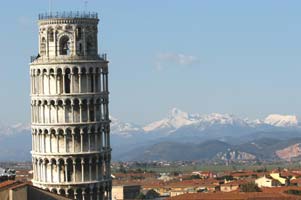Art
From Pisa you can see, when the sky is clear, the imposing chain of the Alpi Apuane and the world famous marble quarries of Carrara. From these quarries comes the white stone with which the buildings of Piazza del Duomo (Cathedral square) were built. Italy and Europe are full of beautiful cities, but few have reached the perfection and harmony of Pisan architecture. The Pisan artists introduced a new architectural style which is known today as "Romanico pisano" (Pisan romanesque): you can admire it in many churches, first of all in the splendid Cathedral where the alternation of white and black bands, the sequence of blind arches, the seuccession of "loggette" create an atmosphere of unsurpassed beauty. What strikes one most in Pisa, more perhaps than in other Italian or European cities of art, is the great variety of architectural styles of its monuments. This is not surprising in view of Pisa's long history and of the many external influences to which Pisa has been exposed; indeed because of her active foreign trade Pisa had always been a meeting place of different people, different cultural traditions, different artistic conceptions. It has always been a special gift of the Pisans to be particularly receptive to external influences and to be able to blend and harmonize them into new, original forms of expression. It was in this complex and cosmopolitan milieu that the so called Pisan-Romanesque style was born, the true hall-mark of the city and her permanent legacy to world's art.
What strikes one most in Pisa, more perhaps than in other Italian or European cities of art, is the great variety of architectural styles of its monuments. This is not surprising in view of Pisa's long history and of the many external influences to which Pisa has been exposed; indeed because of her active foreign trade Pisa had always been a meeting place of different people, different cultural traditions, different artistic conceptions. It has always been a special gift of the Pisans to be particularly receptive to external influences and to be able to blend and harmonize them into new, original forms of expression. It was in this complex and cosmopolitan milieu that the so called Pisan-Romanesque style was born, the true hall-mark of the city and her permanent legacy to world's art.
However Pisa's artistic life didn't begin with the Pisan-Romanesque style , neither did it end with it. Indeed archeologists have discovered and keep discovering inside the town itself and its suburbs imposing ruins dating back to the Etruscan and Roman times. Just a few years ago an important Etruscan necropolis was discovered near a little town, Gagno, and even more recently, close to the railway station of San Rossore, a large number of Roman ships were accidentally uncovered in the course of some repairing works. Moreover the severe and unadorned features of some of the oldest churches ( San Frediano , San Sisto and San Pietro in Vinculis, for example) clearly belong to the earliest romanesque style, whereas the elegant façades of other churches ( Santa Caterina ,San Michele in Borgo and the delicate church of Madonna della Spina ) are examples of pure gothic style.
The XVth and XVIth centuries, the period when the linear and classical style spread all over Italy, have left their mark on several palaces and churches, in particular on the magnificent Piazza dei Cavalieri: even the sumptuous baroque style is present expecially in the interior of several churches.
Also the XIXth and XXth centuries have left their mark on Pisan architecture: the solemn and imposing Teatro Verdi is an example of the official style of the 19th cenury; the Palazzo della Prefettura and the facade of the Convento delle Benedettine are representative of the "Gothic revival" period; the Liberty style has inspired some elegant private residences and even the so-called austere Fascist style has left ist mark on some public buildings. All these buildings testify the vitality of Pisan architecture in modern times.
Nevertheless it is undoubtebly the Pisan-Romanesque style the most significant and original characteristic of the town. Its most impressive expression is to be found in the Cathedral dedicated to the Assumption of the Virgin Mary, the real centre of the beautiful Piazza del Duomo . In the buildings of the Piazza the great artists of the golden age of the Pisan Repubblic (from Buscheto to Bonanno Pisano and Diotisalvi to mention just a few) succeded in grafting on the linear and sober romanesque style oriental elements coming from different traditions, Armenian, Arabic and bizantine. With their extraordinary artistic talent and their supreme command of building techniques, the great Pisan masters created that special style that is commonly found in so many facades of the Pisan churches (from the Cathedral to San Paolo a Ripa d'Arno ) and in so many of the Tuscan cathedrals (Lucca, Carrara, Pistoia): everywhere in Tuscany the blind arcades, the classical alternating white and black bands, the geometrical squares and diamonds decorations, the many sequences of delicate loggias, testify to the high level of cultural and economic power that Pisa's Republic enjoyed almost a thousand years ago
